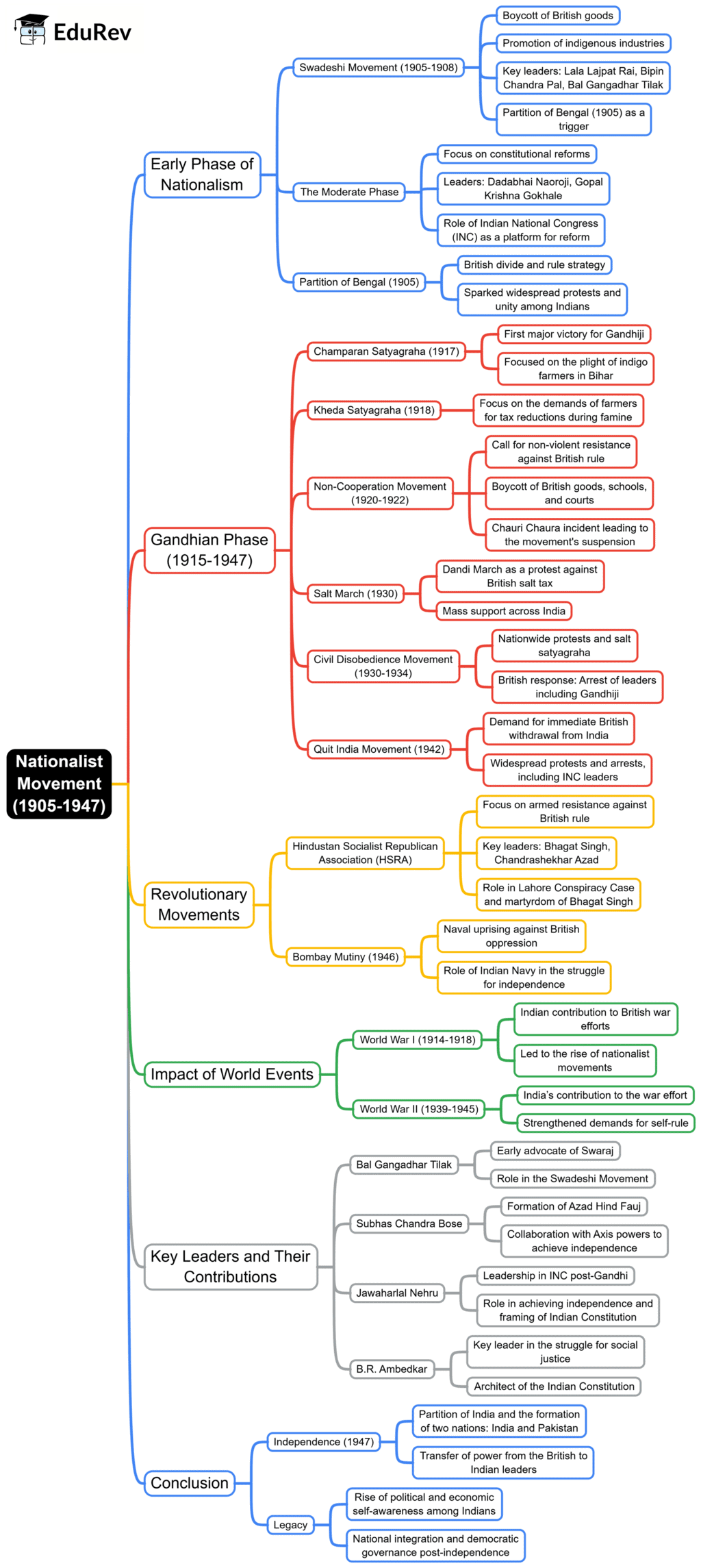UPSC Exam > UPSC Notes > History for UPSC CSE > Mind Map: Nationalist Movement (1905-1947)
Mind Map: Nationalist Movement (1905-1947) | History for UPSC CSE PDF Download

The document Mind Map: Nationalist Movement (1905-1947) | History for UPSC CSE is a part of the UPSC Course History for UPSC CSE.
All you need of UPSC at this link: UPSC
|
216 videos|855 docs|219 tests
|
FAQs on Mind Map: Nationalist Movement (1905-1947) - History for UPSC CSE
| 1. What were the main causes of the Nationalist Movement in India during the early 20th century? |  |
Ans. The Nationalist Movement in India during the early 20th century was primarily driven by several factors. The impact of British colonial rule, including economic exploitation, social discrimination, and political unrepresentation, fueled discontent among Indians. The rise of Western education and political consciousness among the Indian middle class also played a vital role. Additionally, events like the partition of Bengal in 1905 and the repressive policies of the British government, such as the Rowlatt Act, intensified the demand for self-rule and unity among various Indian communities.
| 2. How did the First World War influence the Indian Nationalist Movement? |  |
Ans. The First World War had a significant impact on the Indian Nationalist Movement. The British government recruited Indian soldiers and demanded resources from India to support the war effort, which led to promises of political concessions post-war. However, the subsequent disappointment with the lack of reforms and the imposition of repressive laws, such as the Rowlatt Act, increased anger and unrest among Indians. This period saw the rise of mass movements, with leaders like Mahatma Gandhi advocating for non-violent resistance, culminating in widespread protests and the Non-Cooperation Movement.
| 3. What role did Mahatma Gandhi play in the Indian Nationalist Movement? |  |
Ans. Mahatma Gandhi emerged as a pivotal leader in the Indian Nationalist Movement, advocating for non-violent resistance and civil disobedience. His philosophy of Satyagraha emphasized truth and moral righteousness as tools for political struggle. He led several key movements, including the Non-Cooperation Movement in the 1920s and the Salt March in 1930, which galvanized public support and demonstrated the effectiveness of peaceful protests against British rule. Gandhi's approach helped unite diverse sections of Indian society in the fight for independence.
| 4. What were the significant events leading to the Quit India Movement? |  |
Ans. The Quit India Movement was a culmination of various significant events and policies that fueled Indian discontent. Key events included the failure of the Cripps Mission in 1942, which proposed a limited form of self-government, and the worsening economic conditions due to World War II. The growing frustration with British inaction and the desire for immediate independence prompted leaders like Gandhi to call for "Do or Die" in the Quit India resolution. The movement witnessed mass protests, despite severe repression by the British authorities.
| 5. How did the partition of India in 1947 affect the Nationalist Movement? |  |
Ans. The partition of India in 1947 marked a significant and tragic outcome of the Nationalist Movement. As the demand for a separate Muslim state led to the creation of Pakistan, it caused widespread communal riots, mass migrations, and loss of lives. The partition was seen as a failure to achieve a united India as envisioned by many nationalists. It also highlighted the divisions within the movement and raised questions about the future of communal harmony in the newly independent nations, influencing the political landscape of India and Pakistan for decades to come.
Related Searches
















